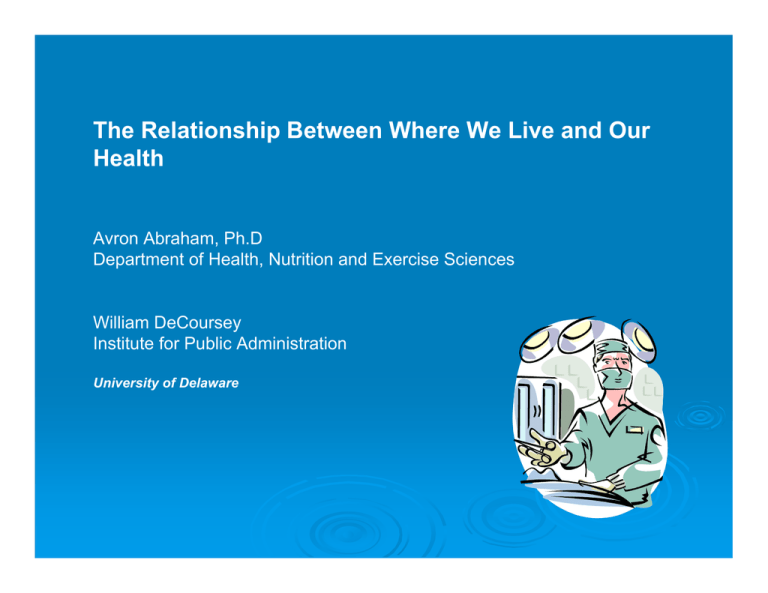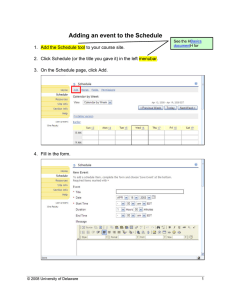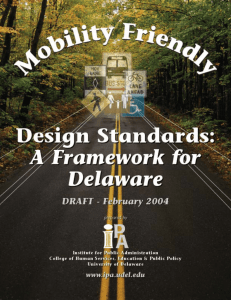The Relationship Between Where We Live and Our Health
advertisement

The Relationship Between Where We Live and Our Health Avron Abraham, Ph.D Department of Health, Nutrition and Exercise Sciences William DeCoursey Institute for Public Administration University of Delaware Healthy Communities - Project Overview Collaboration between the Department of Health, Nutrition, and Exercise Sciences and the Institute for Public Administration Funded by a grant from the Delaware Department of Health and Social Services (DHSS) IPA has been working in municipal planning since the late 90’s and has helped over 20 towns with their comprehensive plans. Healthy Communities - Project Overview Identify five partner communities Conduct a mobility-friendly assessment Craft a report for each community detailing barriers to walkability and opportunities for physical activity Coordinate with a working committee from each community to devise an implementation plan. Money, money, money The connection between the way we build our communities and key public health trends such as: •Obesity •Asthma •Depression •Hypertension •Diabetes So the way we design communities and transportation systems to create walkable/bikeable neighborhoods, preserving open space, can help people maintain healthy habits. American Journal of Health Promotion: Vol. 18, No 1, 2003 Cumulative Mortality by Distance Walked per Day Mortality (%) 50% 0 to 0.9 miles/day 1.0 to 2.0 miles/day 2.1 to 8.0 miles/day 40% 30% 20% 10% 0% 0 2 4 6 8 10 Year of Follow-up Hakim NEJM 1998;338:94-9. 12 Disturbing Trends Trips to School by Distance and Mode 60 Youth Ages 5-15 (1995) 51 50 Percent of Trips 50 41 40 30 Auto School Bus Walk 20 Bike Other 31 10 0 14 3 1 mile or less 5 1 1 3 Between 1 and 2 miles Calculations from the 1995 Nationwide Personal Transportation Survey. US Department of Transportation, Federal Highway Administration, unpublished data, 2000. Reported Barriers to Walking & Biking to School (1999) Percentage of Respondents 60 55 50 40 40 30 26 24 18 20 16 7 10 0 Distance 1999 HealthStyles Survey Traffic Other Weather Crime School Policy No Barriers Surveys show that voters would support using Local, State, & Federal Funds... 54% for more bike paths 61% for more sidewalks 72% for mandatory sidewalks in new developments 70% to help ensure the safety of children to walk or ride bicycles to school Source: EPA/CDC:Greenstyles Survey; Healthsyles 2000 Interventions addressing chronic disease risk factors , such as physical inactivity require, comprehensive, population-based approaches that incorporate both individual and societal-level strategies. Incorporation of both active and passive approaches Examples: •Schools •Community •Worksites •Recreation The major impediment to use of the bicycle for transportation in sprawled suburbs is lack of connectivity. Consider the picture below: School Barriers to Walking and Biking Street connectivity Street design Site location/design Traffic volume/speed Travel choice Social norm Time Crime Little separation exists between pedestrian and vehicular environments Tree lawns and unique paving patterns create a safer, more pedestrian environment. Directional signage was developed that reflects the historic character of the Village So what are we doing in Delaware? •Delaware Division of Public Health – PSC 0687 •Executive Order Number 83 •Wilmapco/Greenways/DelDOT/ New Castle County/DE State Parks/ Delaware Greenways and local government Examples of National Initiatives: •NGA – National Governor’s Association •Smart Growth •Active Living By Design •National Coalition to Promote Physical Activity •Physical Activity Policy Research Network •Active Transport To and From School: A Multi-site Exploration of Physical Activity Policy •Exploring Policy Change in the Development of Community Trails





